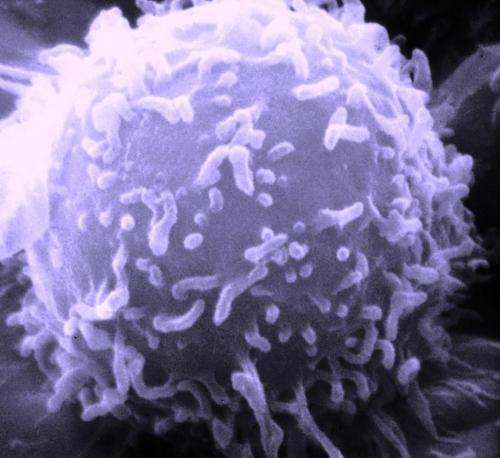Scientists modify CAR-T cells to target multiple sites on leukemia cells

In a new pre-clinical study published this week in the journal Leukemia, the research team of Children's Hospital Los Angeles investigator Hisham Abdel-Azim, MD, MS, worked with colleagues to engineer T-cells to identify and target multiple sites on acute lymphoblastic leukemia cells instead of just one. The early collaboration points the way to future clinical trials to test the therapy.
Acute Lymphoblastic Leukemia (ALL) is the most common childhood cancer. Though most children respond well to chemotherapy, some experience resistant or relapsed disease. CAR-T therapy was developed to bridge the gap for those children for whom chemotherapy was not enough.
The therapy uses the patient's T-cells, isolating and genetically modifying them to recognize CD-19, a protein (antigen) found on leukemia cells. When the T-cells are introduced back into the patient, the immune system attacks the cancer. Though initial treatment using CAR-T offered meaningful results, nearly half of patients who received the therapy later relapsed because the cancer stopped producing the protein CD-19 and became invisible to the T-cells.
Dr. Abdel-Azim collaborated with Nabil Ahmed, MD, MPH, of Baylor College of Medicine and Texas Children's Hospital, to engineer a T-cell that targets not only CD19, but also two other proteins found on leukemia cells, CD-20 and CD-22.
"It's like using a trident to attack the cancer instead of a spear," says Dr. Ahmed. The team used this three-pronged weapon against leukemia cells in pre-clinical studies and developed new methods to monitor how well it worked.
The new CAR T-cells, named TriCAR T-cells, targeting CD-19/20/22 are significantly more effective than T-cells that target CD-19 alone, according to the study's findings. When the leukemia cells stopped producing CD-19, making them invisible to the FDA-approved CAR-T cells, Dr. Abdel-Azim's cells were still effective. "These newer CAR-T cells bind to more cancer cells and these connections are much stronger," says Dr. Abdel-Azim. "Not only do they bind better, but they are binding again and again." These connections show just how effective the new CAR-T cells are in killing leukemia cells. More T-cell binding means a stronger fight against the cancer.
Though a clinical trial will be needed before the new CAR-T therapy could be used on patients, the early lab results point the way to a path that could be significantly more effective in battling resistant leukemia.
Just like attacking more than one antigen is more effective in the fight against leukemia, so too is combining investigative forces. "Scientific findings like these would not be possible without collaboration," says Dr. Abdel-Azim.
More information: Kristen Fousek et al, CAR T-cells that target acute B-lineage leukemia irrespective of CD19 expression, Leukemia (2020). DOI: 10.1038/s41375-020-0792-2


















